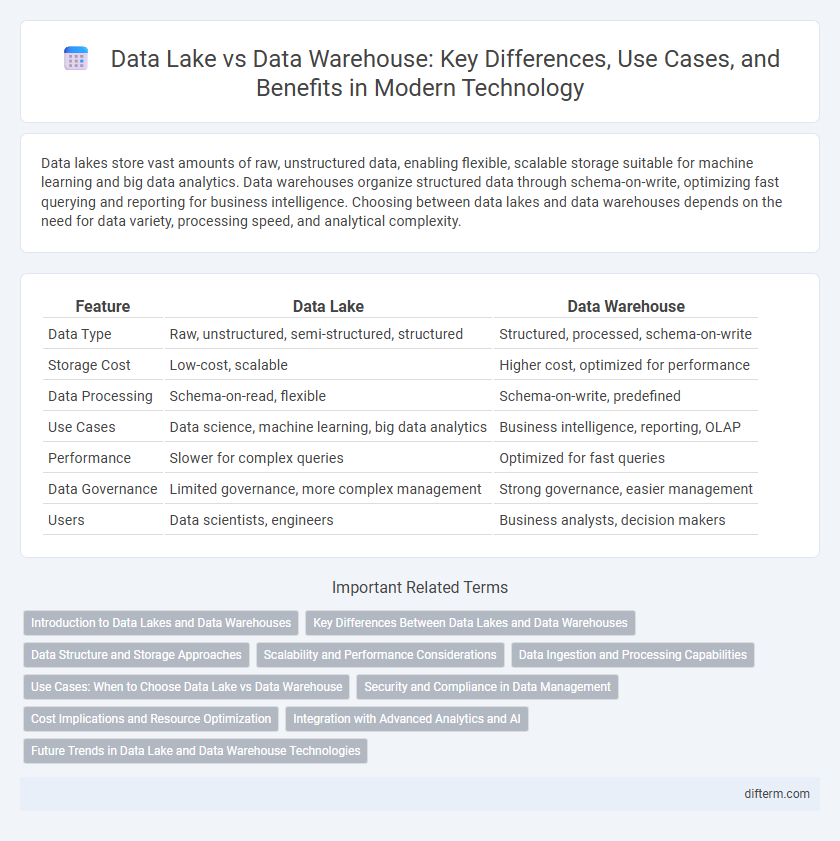Data lakes store vast amounts of raw, unstructured data, enabling flexible, scalable storage suitable for machine learning and big data analytics. Data warehouses organize structured data through schema-on-write, optimizing fast querying and reporting for business intelligence. Choosing between data lakes and data warehouses depends on the need for data variety, processing speed, and analytical complexity.
Table of Comparison
| Feature | Data Lake | Data Warehouse |
|---|---|---|
| Data Type | Raw, unstructured, semi-structured, structured | Structured, processed, schema-on-write |
| Storage Cost | Low-cost, scalable | Higher cost, optimized for performance |
| Data Processing | Schema-on-read, flexible | Schema-on-write, predefined |
| Use Cases | Data science, machine learning, big data analytics | Business intelligence, reporting, OLAP |
| Performance | Slower for complex queries | Optimized for fast queries |
| Data Governance | Limited governance, more complex management | Strong governance, easier management |
| Users | Data scientists, engineers | Business analysts, decision makers |
Introduction to Data Lakes and Data Warehouses
Data lakes store vast amounts of raw, unstructured data in its native format, enabling flexible and scalable data ingestion from diverse sources. Data warehouses organize structured, processed data optimized for fast querying and analytics, supporting business intelligence and reporting needs. Both play critical roles in modern data architectures, with data lakes offering agility and data warehouses providing performance for decision-making.
Key Differences Between Data Lakes and Data Warehouses
Data lakes store raw, unstructured, and semi-structured data, allowing for flexible schema-on-read processing, whereas data warehouses handle structured data with predefined schemas optimized for fast querying and reporting. Data lakes utilize low-cost storage systems supporting vast volumes and diverse data types, while data warehouses use expensive, high-performance storage designed for complex analytical workloads. Metadata management in data warehouses is rigid and schema-driven, contrasting with the dynamic, schema-on-read approach enabling agile analytics in data lakes.
Data Structure and Storage Approaches
Data lakes store vast amounts of raw, unstructured, and semi-structured data in its native format, using flat architecture and scalable object-based storage systems such as Amazon S3 or Azure Data Lake Storage. Data warehouses employ a structured schema-on-write approach, organizing data into relational tables optimized for complex queries and analytics, often utilizing columnar storage formats like Parquet or ORC. This fundamental difference in data structure and storage methods impacts their respective use cases, with data lakes excelling in agility and flexibility, while data warehouses prioritize performance and data integrity.
Scalability and Performance Considerations
Data lakes provide superior scalability by storing vast amounts of unstructured and structured data with flexibility for growth, using low-cost storage solutions like object storage. Data warehouses optimize performance for complex queries and analytics through structured schema design and indexing but may face limitations scaling beyond petabyte levels due to costly compute and storage resources. Choosing between a data lake and data warehouse depends on balancing scalability needs with the requirement for high-performance analytics workflows.
Data Ingestion and Processing Capabilities
Data lakes support diverse data ingestion methods, handling structured, semi-structured, and unstructured data from sources like IoT devices, social media, and logs with schema-on-read flexibility. Data warehouses optimize for structured data, using schema-on-write processes and ETL pipelines to ensure high data quality and consistency suited for business intelligence. Real-time streaming and batch processing are integral to data lakes, while data warehouses primarily rely on batch processing for analytics.
Use Cases: When to Choose Data Lake vs Data Warehouse
Data lakes are ideal for storing vast amounts of raw, unstructured, or semi-structured data, making them suitable for big data analytics, machine learning, and exploratory data science projects. Data warehouses excel in processing structured data for business intelligence, reporting, and complex queries requiring high performance and data integrity. Organizations typically choose data lakes for flexibility and scalability when handling diverse data sources, while data warehouses are preferred for consistent, curated datasets with fast query execution and compliance requirements.
Security and Compliance in Data Management
Data lakes offer flexible schema-on-read capabilities but pose challenges in enforcing strict security and compliance protocols compared to data warehouses. Data warehouses provide robust access controls, data masking, and auditing features essential for regulatory compliance such as GDPR and HIPAA. Organizations prioritize data warehouses for sensitive data due to their mature governance frameworks and consistent policy enforcement mechanisms.
Cost Implications and Resource Optimization
Data lakes offer cost-effective storage by utilizing low-cost hardware and supporting unstructured data, reducing expenses associated with preprocessing and schema design. Data warehouses typically require higher investment due to structured data management, extensive ETL processes, and expensive proprietary software licenses. Resource optimization in data lakes is enhanced by scalability and flexibility, while data warehouses focus on performance tuning and optimized query execution for predefined schemas.
Integration with Advanced Analytics and AI
Data lakes excel in integrating with advanced analytics and AI by providing a flexible repository for raw, unstructured, and semi-structured data, enabling machine learning models to access diverse datasets for training and real-time analysis. Data warehouses, while optimized for structured data and business intelligence, support AI through curated datasets that improve query performance and data consistency for predictive analytics. Both platforms complement each other by offering scalable environments that enhance data-driven decision-making and AI-powered insights.
Future Trends in Data Lake and Data Warehouse Technologies
Future trends in data lake and data warehouse technologies emphasize the integration of advanced AI-driven analytics and real-time data processing capabilities to enhance decision-making accuracy and operational efficiency. Cloud-native architectures and serverless computing are driving scalability and cost-effectiveness, enabling seamless handling of growing data volumes across diverse sources. Enhanced data governance frameworks and automated metadata management are increasingly critical for maintaining data quality, security, and compliance in hybrid and multi-cloud environments.
data lake vs data warehouse Infographic

 difterm.com
difterm.com